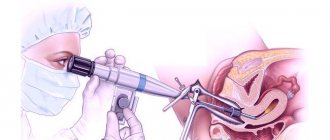An ectopic pregnancy is a condition that threatens the patient’s life. To make a diagnosis, the ultrasound diagnostic method is used. If an ectopic pregnancy is detected by ultrasound, emergency hospitalization is required. The tactics of further treatment will depend on the location of the ovum, which is also determined using this method.
Is it possible to detect an ectopic pregnancy on an ultrasound?
Is an ectopic pregnancy visible on an ultrasound? It all depends on the method of manipulation. As well as the time that has passed since the attachment of the fertilized egg outside the uterine cavity.
There are 2 main methods of ultrasound examination of the pelvic organs:
- transvaginally;
- transabdominal.
In the first case, the sensor is inserted into the vagina, in the second it remains outside the body. Both methods do the job well. The use of any of them helps not only to detect an ectopic pregnancy, but also to assess the condition of nearby blood vessels, organs, and tissues.
Today, doctors are increasingly resorting not to standard ultrasound, but to three-dimensional echography. Unlike the two-dimensional method, which shows planar sections, 3D ultrasound creates a three-dimensional image of the fetus in real time.
Causes
There are several factors that can provoke abnormal fixation of a fertilized egg:
- inflammatory processes in the pelvic organs, which in most cases occur against the background of infectious diseases;
- benign/malignant neoplasms in the ovaries, compressing the fallopian tubes;
- endometriosis, in which the lining of the uterus grows into the fallopian tubes, causing them to become blocked;
- congenital anomalies of the genital organs;
- consequences of abortion, previous operations on the tubes and uterus, which led to the formation of adhesions;
- use of intrauterine contraceptives.
In addition, the reasons that cause a predisposition to pathology include hormonal imbalances, exposure to stress, age over 35 years, bad habits (drinking alcohol, smoking). Also, according to statistics, in 10% of cases, ectopic pregnancy is observed after in vitro fertilization.
Signs of ectopic pregnancy on ultrasound
Indications for performing an ultrasound during an ectopic pregnancy are signs of an abnormal location of the ovum. They manifest themselves as bloody, spotting discharge from the genitals, pain in the lower abdomen. The combination of such symptoms allows one to immediately suspect pathology.
On ultrasound, an ectopic pregnancy looks like this:
- fluid accumulation;
- increase in uterine volume in the absence of fibroids;
- formation of a blood clot in the uterus, not an embryo;
- increased secretion production by the endometrial glands;
- the formation of corpus luteum cysts, neoplasms of various shapes and volumes, localized in the appendages.
Ultrasound diagnostics helps determine a specific type of pathological condition. If there is a fertilized egg in the cervix, it is visualized by its enlargement. If the embryo is in the peritoneum, oligohydramnios and thickening of the placenta are detected.
Diagnosis of interrupted abnormal pregnancy
With abnormal attachment of the fertilized egg, there are four possible pathology development options:
- progressive ectopic pregnancy;
- non-developing ectopic pregnancy;
- pregnancy terminated spontaneously;
- pregnancy interrupted as a result of a ruptured tube.
The consequence of an interrupted tubal pregnancy is often hemorrhagic shock. There is pain on palpation of the anterior abdominal wall. Sometimes even with hemorrhagic shock the pain may be insignificant. In 15% of cases, patients report discomfort in the collarbone or shoulder due to nerve irritation. Differential diagnosis of cyst rupture and splenic rupture is necessary.
Probability of errors
If the diagnostic procedure is performed too early (before 5 weeks), then the data obtained may be false. This is also true in other cases:
- using an outdated device with a limited range of capabilities;
- equipment malfunction not noticed by a specialist;
- the similarity of a blood clot in the uterine cavity with a developing embryo.
False-positive data in the protocol are often explained by the lack of differential diagnosis. Signs of spontaneous threatening, complete or incomplete abortion, hydatidiform mole, and uterine bleeding are masked as pathology.
There are similarities in clinical features between ectopic pregnancy and inflammation of the appendix, ruptured cysts, infection of the genitourinary system, renal colic, ovarian torsion, and acute salpingitis. Only by excluding these pathologies can an accurate diagnosis be made.
Accuracy of diagnosis
In some cases, an ultrasound examination cannot make an accurate diagnosis. In addition, mistakes often occur. Several reasons contribute to these factors:
- short pregnancy period (less than 4-5 weeks);
- old-style diagnostic equipment that does not have the necessary set of functions;
- possible malfunctions of the ultrasound machine;
- lack of appropriate qualifications and experience of a diagnostic specialist.
In addition, in order to eliminate inaccuracies and errors, a differential analysis of diseases whose symptoms are similar to those of VMB should be carried out. Such pathologies include: uterine fibroids, rupture of a cyst or ovary, benign/malignant formations, appendicitis, corpus luteum cyst, etc.
Other ways to detect pathology
There are other ways to determine an ectopic pregnancy without an ultrasound. A common laboratory diagnostic method is the hCG test. This is the name for the quantitative determination of human chorionic gonadotropin, which is produced by a fertilized egg.
Its structure contains alpha and beta units. But only the latter appear in the plasma 1.5–2 months after conception. If the pregnancy is normal, then their number increases by half every second day. This does not happen with an ectopic one.
Laboratory diagnostic methods
In case of ectopic pregnancy, blood tests for hCG content, progesterone concentration, and a general clinical analysis are indicated. In case of abnormal attachment of the fertilized egg, the results of hCG in the blood or urine are positive. With normal attachment in the first few weeks, the content of the beta subunit doubles approximately every two days, with an ectopic level it grows more slowly. Usually blood is donated over time at intervals of 48 hours. In 85% of tubal pregnancies, the hormone concentration increases less than twice.
The level of progesterone in normal pregnancy already in the first weeks exceeds 25 ng/ml. When ectopic, the concentration remains below 5 ng/ml. But this does not allow us to accurately establish the fact of improper attachment of the fertilized egg and distinguish an ectopic pregnancy from fetal death during an intrauterine one. In addition, in a large number of patients with suspected tubal pregnancy, progesterone levels fluctuate between 5 ng/ml and 25 ng/ml, which reduces the diagnostic value of the study.
As for the results of other laboratory tests, the white blood cell count can increase to 10-15 thousand μl-1, and hemoglobin and hematocrit often remain normal even with intra-abdominal bleeding.
Where can an ectopic pregnancy be located?
Ultrasound can detect an ectopic pregnancy regardless of its location. It can be tubal, ovarian, abdominal. Quite rarely, a fertilized egg moves into the rudimentary uterine horn.
A heterotopic pregnancy stands apart, when an ultrasound examination reveals two fertilized eggs in different places. One of them is located in the uterus, the other is outside it.
If characteristic signs of an anomaly appear, you should immediately contact a gynecologist. Further measures will depend on the diagnostic results. According to indications, the fallopian tube is completely removed (tubectomy) or only the fertilized egg is excised from it (tubotomy).
Transvaginal ultrasound is the most accurate method for detecting ectopic pregnancy. But its results can also be false positive or false negative. Not in every case pathology is detected. To make a correct diagnosis, it is advisable to combine ultrasound diagnostics with other methods.
Photo: yandex.ru
About the procedure
A number of characteristic symptoms indicate that fertilization of the egg has occurred. But in the case of an ectopic pregnancy, along with the classic signs, there will also be specific ones:
- absence of menstruation;
- nagging pain in the lower abdomen, severe pain is possible;
- bloody issues;
- positive or weakly positive test;
- The hCG level is elevated, but low for a specific period.
Diagnosis of ectopic pregnancy by ultrasound is possible from the fifth week from the moment of conception. Already at such early stages, the study will show where the fertilized egg is located.
When the fetus is outside the uterus, it affects the organs and tissues located next to it. As a result, it damages them and can cause internal bleeding.
If the pathology is not diagnosed in time, the pregnant woman may die. Since ultrasound shows an ectopic pregnancy, the value of this method in detecting an anomaly is undeniable.
To watch a program on this topic:
Useful video about ultrasound for ectopic disease
List of sources:
- Bobrovnikova E. O., Ostapenko O. M. Modern methods of diagnosis and treatment of cervical pregnancy // Bulletin of medical Internet conferences, 2020.
- Great Medical Encyclopedia. Ectopic pregnancy.
- Sharipov Gairatshokh Nusratulloevich, Khodzhamuradova J.A., Khodzhamuradov G.M., Saidov M.S. Features of ultrasound examination of patients with tubal form of ectopic pregnancy // Avicenna Bulletin, 2020.
Author
Lyudmila Sheveleva
Author of the portal Mama66.ru
All articles by the author
I like!
When to call an ambulance
Don't wait and seek emergency medical help if:
- You experience severe pain that lasts more than a few minutes.
- You are bleeding.
- Acute pain in the rectum is accompanied by a feeling that you have an unbearable need to go to the toilet.
- The shoulder hurts severely and for a long time (more than a few minutes). Sometimes the blood that rushes into the abdominal cavity after a fallopian tube ruptures accumulates near the diaphragm and irritates the nerves connected to the shoulder.
- You feel extremely dizzy, to the point where you feel like you are about to pass out.
Complications and their signs
Often, expectant mothers do not rush to see a doctor, which is why the disease remains undiagnosed. This is very dangerous because it leads to rupture of the appendages, intra-abdominal bleeding and peritonitis. Complicated ectopic pregnancy manifests itself at a period of more than one month with the following symptoms:
- sharp stabbing pain in the lower abdomen, on the right or left side;
- increased sweating, weakness, rapid heartbeat;
- Possible heavy uterine bleeding;
- positive symptoms of peritoneal irritation.
Ectopic pregnancy, complicated by rupture of the adnexa, usually manifests itself at a period of more than one month. It is at this time that the embryo reaches a large size and becomes capable of rupturing the tube.
Attempts at self-medication and ignoring the problem are dangerous. Pregnancy should be under the supervision of a specialist - then you can be sure that complications will not occur at any stage.
Characteristic symptoms
A delay in the menstrual cycle is one of the main factors accompanying this pathology, therefore, if a woman experiences a delay, she should consult a doctor. But the course of ectopic pregnancy is not much different from the early stage of normal pregnancy, with the exception of some features.
Symptoms of ectopic pregnancy
The main symptoms of ectopic pregnancy that accompany a woman include:
- delayed menstruation;
- pain in the lower abdomen;
- bloody issues;
- attacks of nausea and early toxicosis;
- hardening of the mammary glands, which are usually very painful;
- pain radiating to the lumbar region.
Many women mistakenly assume that the absence of a delay in menstruation can indicate the exclusion of the diagnosis of ectopic pregnancy. Women often mistake bloody vaginal discharge for normal menstruation. According to experts, in approximately every fifth case, pathology can be detected even before menstruation is delayed. Therefore, an accurate diagnosis requires a complete examination of the patient and collection of anamnesis.











